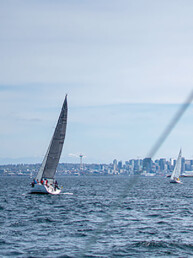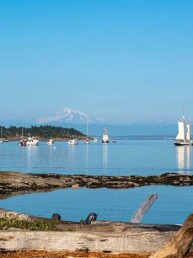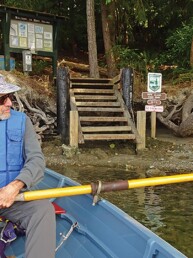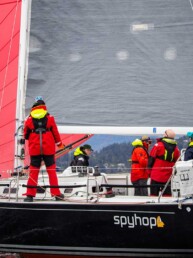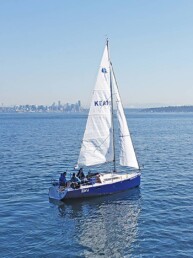Exploring the “Galapagos of the North”
When you think of the Galapagos Islands, what comes to mind is a place teeming with sea life and unique flora and fauna that is hard to get to and relatively untouched by modern humans. That description matches Burnaby Narrows in Haida Gwaii almost perfectly, which is why it is often called The Galapagos of the North.
For boaters in the Pacific Northwest, Haida Gwaii often is — and should be — a cruising destination on the top of your must-visit list. Burnaby Narrows (also called Dolomite Narrows) is the name locals use for this skinny, shallow, rock-infested stretch of water located in Gwaii Haanas National Park Reserve.
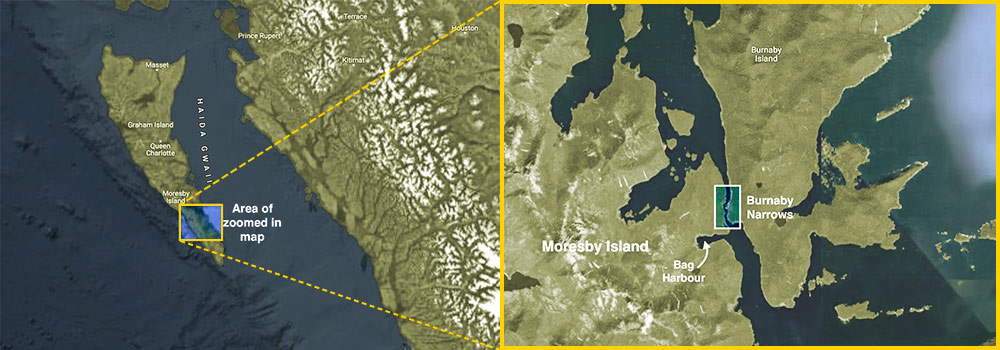
Depending where you depart from, Haida Gwaii is 30 to 70 nautical miles across the shallow, turbulent waters of Hecate Strait from the northern British Columbia mainland coast. Over 200 islands make up the archipelago. The island’s remote location, with little disturbance from the outside world, has allowed plant and animal life here to thrive. The Haida people harvested clams, mussels, crabs, salmon, cod, and even herring roe in and around the rich waters of Burnaby Narrows. It is a surreal experience to explore this distinctive place firsthand.
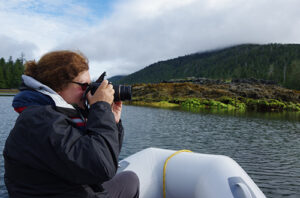
The narrows is a skinny, navigable waterway between Moresby Island to the west and Burnaby Island to the east, reachable only by boat or seaplane. Some come on their own boats, as my wife, Heather, and I did aboard our C&C 39, Nordic Sun, and others come as part of a tour.
The narrows is only about half a nautical mile long and about 150 meters wide and is littered with treacherous rocks. It can be transited by boat, but only at high tide. Most of the worrisome rocks are at the northwest end of the narrows. We chickened out and didn’t go through the narrows when coming down from Windy Bay (a watchman site northwest of the narrows). Instead, we approached from the southeast end and anchored in Bag Harbour to do our exploration.
If you want to transit the narrows, it is suggested that you anchor outside the entrance, then explore the waterway for rocks in your dinghy. When surveying the area, take your handheld GPS along so you can plug in a few useful waypoints to help you navigate safely through in a larger, deeper-draft vessel.
The water runs swiftly through the narrows most of the time, but twice a day at low slack water of the falling tide a cornucopia of sea life in a multitude of vibrant colors, shapes and sizes is unveiled. The water of the narrows is among the most nutrient-rich in the world and supports more sea life than anywhere else on the B.C. coast.
When we visited Burnaby Narrows, low tide was at 9 a.m. the day after our arrival. Before going to bed, I set my alarm for 7 a.m. to be sure we didn’t miss it. When the alarm sounded, I rolled out of my bunk, put the coffee on the stove and made a quick breakfast before we headed for the narrows by dinghy.
As we approached, the crystal clear water shallowed quickly and we could see numerous rock cod darting away from the dinghy in every direction. The cod found a safe place to hide amongst the dancing kelp leaves that were swaying back and forth to the rhythm of the flowing current, like choreographed dancers with long streamers.
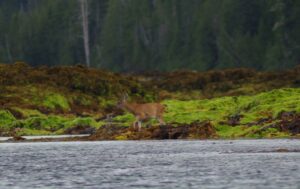
At one point, a Sitka deer contemplated crossing the narrows in front of us, but when it spotted our dinghy, it bolted into the forest. We watched other deer around the narrows and they didn’t seem to mind that we shared their habitat and continued to feed along the beaches. Early non-Haida settlers had brought Sitka black-tailed deer to the islands as a food source. The deer have since thrived due to the mild climate and the lack of predators. Today, there are thousands roaming the islands of Haida Gwaii.
As we motored farther up into the narrows, the water became too shallow to run the outboard and we continued our exploration using oars. Slowly rowing through the narrows, we were awestruck by the numerous sea urchins, starfish, and sea anemones clinging to the drying rocks along the shore. We couldn’t believe the abundance of sea and animal life that live and feed there.
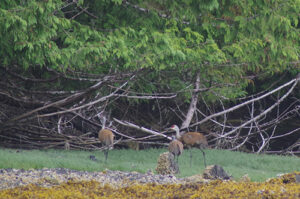
Moving onward, we heard a strange and unfamiliar animal noise coming from farther up the narrows. Keeping a sharp lookout, Heather spotted the creatures making the rattling and honking noises — sandhill cranes. They made a different sound as we approached, and we assumed they were alerting the others in the group to our presence. Sandhill cranes fly great distances every year to nest and raise their young in the unpopulated waterways of Haida Gwaii, and we felt fortunate to see these majestic birds in their natural breeding grounds.
At the shallowest part of the narrows there are numerous tide pools. The plants and sea life inhabiting them display an artist’s palette of brilliant colors. The bat stars were an amazing example of the multitude of colors one species can possess — some were red, some were orange, and there were even blue, purple, and spotted ones. There were moon snails with their sand-collar egg masses and other large and small snails crawling in and around the rocks. Mussels and clam shells littered the seafloor.
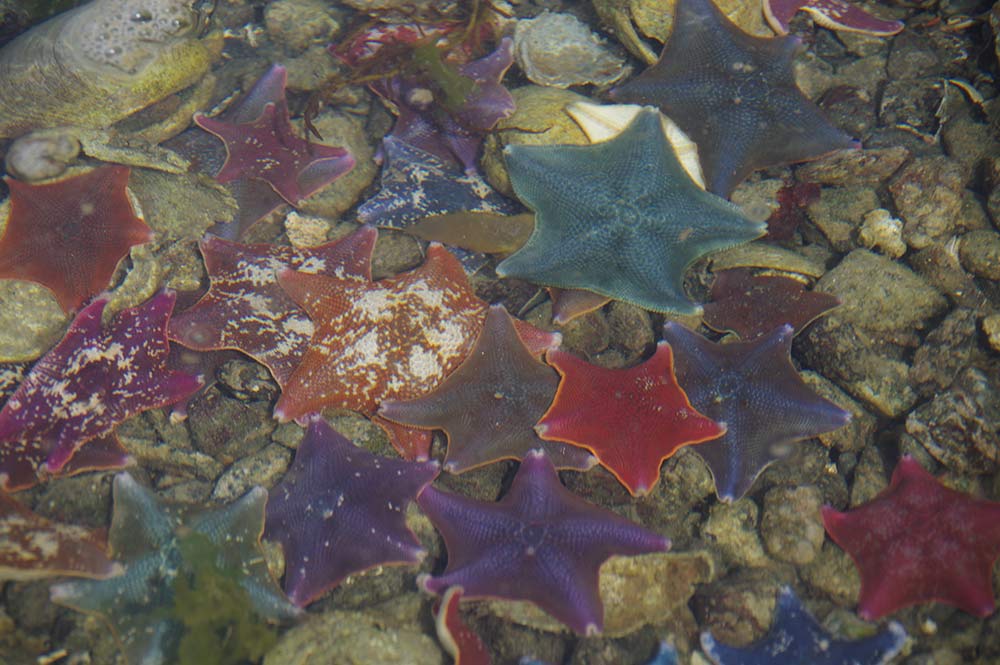
A rock crab spotted our approaching dinghy and did its best to get away from us, scurrying across the shallows towards the water’s edge in a sideways walk. It stopped to hide, motionless, hoping we wouldn’t notice it amongst the rocks and seaweed.
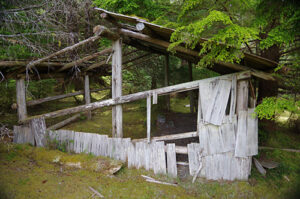
The narrows and surrounding area are not completely pristine, though. Just to the northeast on the eastern shore of Burnaby Island there are two single-room cabins from old homesteads, both dilapidated and constructed of logs and cedar shakes. One was still standing in a shell of its former glory, while the other had almost completely fallen down. I had to wonder, who lived in these tiny one-room cabins? And what were they doing in this remote wilderness?
That afternoon we continued our exploration around the perimeter of Bag Harbour, looking for other historical and natural wonders along the shoreline. The only relic we could find was an old boiler on the beach, slowly rusting away in the salty environment. The uplands around the harbor were covered with a thick layer of moss that looked like three inches of freshly fallen, fluffy green powdery snow. Even the trees were coated and dripping with moss, which swayed back and forth in the gentle breeze. The cedar trees also showed evidence of the bark being partially stripped off, a common practice among Haida people to get materials for making baskets, hats, and even clothing.
After spending a wonderful day exploring Burnaby Narrows and Bag Harbour, we headed back to Nordic Sun for sundowners and a baked rockfish dinner. Soaking up the final remnants of daylight from the comfort of our cockpit, we marveled at the scenery. The pure beauty of this secluded part of Haida Gwaii is the most amazing seascape I have ever had the pleasure to visit. With the sun setting to the west over Yatza Mountain on Moresby Island, our time at Burnaby Narrows came to a picturesque and perfect ending.
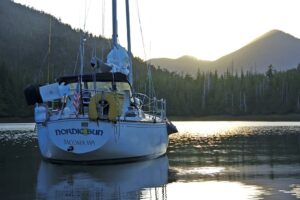
Greg Larsen is a cruiser and racer with a lifetime of sailing experience. He and his family have been cruising the waters of the Salish Sea from Olympia to Alaska for decades.
Greg Larsen
Cruiser/Racer with a lifetime of sailing experience, Greg and his family have been cruising the waters of the Salish Sea from Olympia to Alaska for decades.
